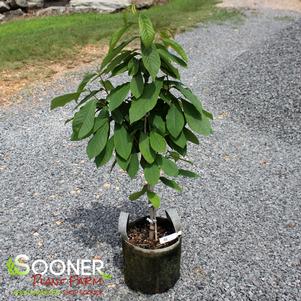
Know Your Zone
Enter your zip code to look up your hardiness zone region.
#6122
SWEET ALICE PAWPAW
Asimina triloba 'Sweet Alice'
Availability
These Units Are Currently Ready to Ship
These items can be added to your Shopping Cart.
These Units Are Currently Out of Stock
Check back regularly for updated inventory.
These Units Are Currently Growing On Our Farm
We are waiting for them to become ready to ship. These items can be added to your Shopping Cart.
Orders containing Online Pre-Order items will be scheduled to ship based on projected ready dates.
These Units Are Currently In Production
These items are currently in production and do not have a projected ready date at this time. These items cannot be added to your Shopping Cart.
Please call to pre-order (918) 453-0771.
Root Pouch 5 gallon - 3-4 ft tall
(SKU: 18272)
0 - Available Now -
Details
2 - Call in Pre-Order (S) - Details - Review Scheduled 4/1/26
Grown in Root Pouch®.
List Price $185.00 Per Plant
Hardiness Zone: 5-9 · Mature Height: 12-15 Feet · Mature Spread: 12-15 Feet
Buy Sweet Alice Pawpaw online. Sweet Alice Pawpaw is a rare, heirloom fruit tree celebrated for its bountiful harvest of large, sweet, orange-yellow fruits that ripen in September and October. Originally discovered by Homer Jacobs in West Virginia in 1934, this pawpaw has since become a beloved choice for its reliable yield and compact growth habit, making it ideal for smaller yards or as a unique orchard addition.
In spring, Sweet Alice Pawpaw delights with its intriguing purple-brown flowers that bloom in April and May, adding a touch of charm to your garden. This deciduous tree also produces one of the largest fruits of U.S. native pawpaw—a lumpy, yellow-green berry with a tropical flavor reminiscent of banana. To encourage the best fruit set, plant it alongside another pawpaw cultivar for optimal cross-pollination.
With smooth brown bark and lush, simple foliage, the Sweet Alice Pawpaw brings an exotic flair and delicious autumn harvests to any landscape.
Family: Annonaceae · Common Name: PawPaw
FREE with every plant purchased:
- The Sooner Guarantee: For details, click here!
- A pre-applied, pre-measured amount of time release fertilizer that keeps your plant well nourished for up to one year.
- Pre-hydrated Hydro-Gels are included in the top of each container to use when planting as they help retain soil moisture, and plants will establish more quickly with less transplant shock. Plants will also survive drought-like conditions and accidental missed waterings better.
- Planting and Care Instruction brochure.
- Catalogs of new and exciting plant brands, such as Garden Debut® and Proven Winners®.
![]() We use and recommend www.dripdepot.com for our irrigation needs, from simple to install micro and drip systems, to commercial grade irrigation parts and supplies.
We use and recommend www.dripdepot.com for our irrigation needs, from simple to install micro and drip systems, to commercial grade irrigation parts and supplies.
SWEET ALICE PAWPAW Plant Characteristics
Bark Color*
| • | Gray |
Bark Type*
| • | Smooth |
Cultural Information*
| • | Leaf Scorch - High Resistance |
| • | Leaf Spot - High Resistance |
| • | Powdery Mildew - High Resistance |
| • | Root Rot - Low Resistance |
Flower Color*
| • | Purple |
Flower Type*
| • | Fragrant |
Growth Habit*
| • | Upright Growing |
Growth Rate*
| • | Medium |
Leaf Color Fall*
| • | Light Yellow/Brilliant Yellow |
Leaf Color Spring*
| • | Green |
Leaf Color Summer*
| • | Green |
Nature Assets*
| • | Attracts Bees |
| • | Attracts Birds |
| • | Attracts Butterflies |
| • | Attracts Hummingbirds |
| • | Deer Resistant |
Plant Type*
| • | Edibles |
Preferred Soil Conditions*
| • | Adapts Well to Most Soil Types |
| • | Average |
| • | Drought Tolerant |
| • | Moist |
| • | Prefers Low pH (Acidic Soils) |
| • | Tolerates Low pH (Acidic Soils) |
| • | Well-Drained |
Propagation Methods*
| • | Cuttings or Divisions |
Season of Interest*
| • | Early Spring |
| • | Fall |
| • | Late Spring/Early Summer |
| • | Late Summer/Early Autumn |
| • | Spring |
| • | Spring Flowering |
| • | Summer |
0 review(s) for SWEET ALICE PAWPAW
SWEET ALICE PAWPAW Homeowner Growing & Maintenance Tips
Asimina is easy to grow and adapts to most conditions. Feed once a year with a slow release fertilizer.



You must be logged into your customer account to post a review for Asimina triloba 'Sweet Alice'.